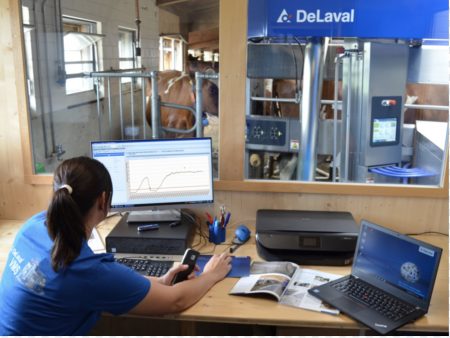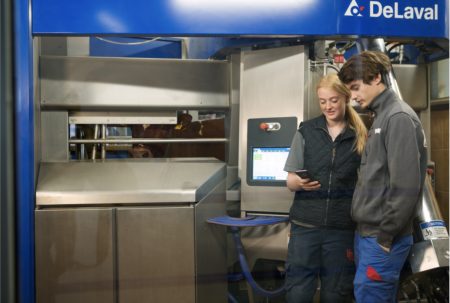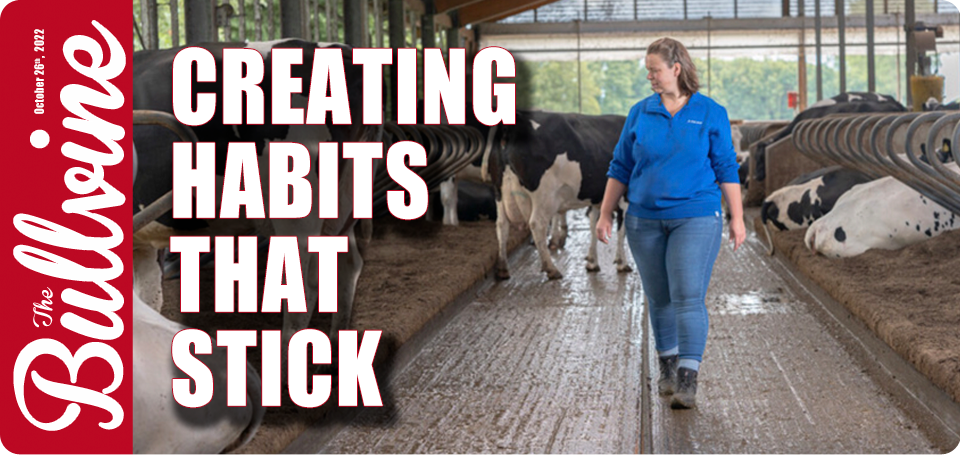Day in and day out, how do you create and stick with the habits that will help you optimize and maximize the performance of your dairy?
In my previous articles, I addressed the idea of change and technology, followed with setting up systems to support your farm’s goals. In this article, I explore the day in and day out of creating habits that will allow you to meet your goals consistently.

Delaval
What is a habit?
A habit is defined as a routine or practice performed regularly; an automatic response to a specific situation.
When adding technology, either software or hardware, on your farm, there are two levels of change:
- Making sure it works as it should.
- Changing how you work to allow it to perform to its potential.
Sometimes this is easy, but most often it has an element of difficulty. When considering adding new technology to your dairy, I recommend speaking with people who recently made a similar switch. Once they are using the new software or hardware for more than a year, they may forget the details from the early months. Even if everything is going well, there was still a time when the change was awkward. The key is minimizing this period and working through it as quickly as possible. .
Getting started
The best way to start new habits is to formulate a plan. Work with your dealer and the company that produces your new technology to help you with a plan that is best for you. A study1 in Great Britain evaluated three groups of people tasked with building better exercise habits over the course of two weeks. The first group was asked to track how often they exercised. The second group was told to track their exercise as well as read material on its benefits. The third group was asked to track how often they exercised, read material on its benefits, and formulate a plan outlining the dates, times and places they were going to exercise. The study found that 91% of the people in the last group exercised at least once per week—double the rate of the other groups.
In formulating your plan to learn and use the new technology, identify someone from the dealership or manufacturer that will sit down with you and discus how you will use it daily, weekly or as it should be used to meet the goals or the reasons for purchasing it.
A plan made possible
Next, make your plan attractive; does it support how you want to work? Long before the first cow is milked by a robot, a robotic dairy operator has a series of decisions to make about managing their

Delaval
cows. For example:
- How much labour do I need to meet my expectations?
- How much labour is available and how much can I afford?
- How many cows per robot or per pen?
- How and where will I attend to cows with special needs?
- Where will I vaccinate, hoof trim and udder singe?
- Will I sync cows or use other technologies to identify cows in heat?
- Where will I breed cows?
Cow Health is extremely important in robot systems because we cannot afford to have cows not feeling or walking well. When this happens, it creates a significant increase in time for our daily routines. One of the top three reasons for purchasing robots is reducing labour. When producers must deal with more sickness and lameness in their daily routines, the time savings that was expected can be greatly reduced. . When discussing the daily routines with the dealership and robotic company, understand the features and limitations of your barn design. When barn design is sacrificed due to retrofits or loan restrictions, the expectations for labour need to be realigned.
Making habits easy allows boring details to be done daily. Having the far away dry cows and , close-up cows grouped, according to the recommended space (150 to 200 square feet) for calving cows, reduces bedding and makes the cows feel safer. Ideally, the design of your facility places the pens where daily routines oversee these cows with minimal labour, resulting in optimal care should a cow require your attention. For herds large enough to have a first lactation group separated from older cows, with animals grouped together for the last three weeks, this will help reduce calving issues and fresh cow issues significantly. Some farms are adapting a calving wall that allows cows to go behind to calve. This mimics their behaviour on pasture where they like to go off on their own to calve. When cows feel safe, their cortisol or stress hormones most likely go down and less issues can result. When your daily chores only include dealing with a normal cow and calf, time is more efficient. When you deal with a calving problem, sick fresh cow or weak calf, your time triples or quadruples. While this example helps with robotic labour efficiency goals, it can apply to any farm system’s goals.
In the Southern Hemisphere, seasonal calving is more common and there is an onslaught of calvings per day. In this situation it is critical to reduce sickness by working with your veterinarian to ensure that the herd is well vaccinated and not too thin, and your team is well organized for monitoring calvings and ensuring newborn calves are collected and worked with to manage any disease challenges. It is one thing to have sick calves for a few weeks or a month when calving is year round, but to have something happen during seasonal calving can be devastating.
Working out the kinks
When working with your team, focus on how to achieve more with less effort. In the book Atomic Habits, author James Clear explains two options for how to increase the rate at which water passes through a hose. The first option is to crank up the valve and force more water out. The second option is to simply remove the bend in the hose and let water flow through naturally.
What in your environment is a bend? What is restricting the flow? Since transition cows hold the key to peak milk production and to fertility, focus on what is making it hard to give them more space. What is making it hard for you to keep an eye on them? What is making it hard to have strong calves, which you can then put into your calf system and have a healthy calf that doubles its weight in 60 days? Until you recognize the bend in the hose that is holding you back from doing what needs to be done to achieve your goals, then you should look at what the system can do. If you want something different, then change the system.

Get original “Bullvine” content sent straight to your email inbox for free.










